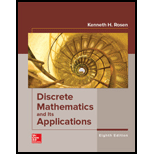
Construct a combinatorial circuit using inverters, OR gates, and AND gates that produces the output
Trending nowThis is a popular solution!

Chapter 1 Solutions
Discrete Mathematics and Its Applications ( 8th International Edition ) ISBN:9781260091991
- A = 5.8271 ± 0.1497 = B 1.77872 ± 0.01133 C=0.57729 ± 0.00908 1. Find the relative uncertainty of A, B, and C 2. Find A-3 3. Find 7B 4. Find A + B 5. Find A B-B - 6. Find A * B 7. Find C/B 8. Find 3/A 9. Find A 0.3B - 10. Find C/T 11. Find 1/√A 12. Find AB²arrow_forwardPlease help on question 16b attached. thxarrow_forwardMath 60arrow_forward
- math 62arrow_forwardB 2- The figure gives four points and some corresponding rays in the xy-plane. Which of the following is true? A B Angle COB is in standard position with initial ray OB and terminal ray OC. Angle COB is in standard position with initial ray OC and terminal ray OB. C Angle DOB is in standard position with initial ray OB and terminal ray OD. D Angle DOB is in standard position with initial ray OD and terminal ray OB.arrow_forwardtemperature in degrees Fahrenheit, n hours since midnight. 5. The temperature was recorded at several times during the day. Function T gives the Here is a graph for this function. To 29uis a. Describe the overall trend of temperature throughout the day. temperature (Fahrenheit) 40 50 50 60 60 70 5 10 15 20 25 time of day b. Based on the graph, did the temperature change more quickly between 10:00 a.m. and noon, or between 8:00 p.m. and 10:00 p.m.? Explain how you know. (From Unit 4, Lesson 7.) 6. Explain why this graph does not represent a function. (From Unit 4, Lesson 8.)arrow_forward
- Make up two polynomial functions, f(x) and g(x). • f(x) should be of degree 3 or higher. g(x) should be of degree 4 or higher. • Find f(3) in each of the three ways: substitution, remainder theorem (synthetic division), and long division. You should get the same answer three times for f(3). Find g(-2) once using your choice of the three methods.arrow_forwardere are many real-world situations that exhibit exponential and logarithmic nctions. • Describe two real world scenarios, one exponential and one logarithmic. Do not identify yet whether your scenarios are logarithmic or exponential.arrow_forwardLauris Online Back to Subject 不 4 ப 12 2 points T 35° 25° R M 4 N P 6Q 5 What is m/MNT? 120 T 12 What is the length of MR? 120 units 167:02:04 Time Remaining Yama is designing a company logo. The company president requested for the logo to be made of triangles. Yama is proposing the design shown. C 64°F Clear Q Search L 13 Ide dia des You scre Edi 12 L Tarrow_forward
- stacie is a resident at a medical facility you work at. You are asked to chart the amount of solid food that she consumes.For the noon meal today, she ate 1/2 of a 3 ounce serving of meatloaf, 3/4 of her 3 ounce serving of mashed potatoes, and 1/3 of her 2 ounce serving of green beans. Show in decimal form how many ounces of solid food that Stacie consumedarrow_forwardFind the area of the shaded region. (a) 5- y 3 2- (1,4) (5,0) 1 3 4 5 6 (b) 3 y 2 Decide whether the problem can be solved using precalculus, or whether calculus is required. If the problem can be solved using precalculus, solve it. If the problem seems to require calculus, use a graphical or numerical approach to estimate the solution. STEP 1: Consider the figure in part (a). Since this region is simply a triangle, you may use precalculus methods to solve this part of the problem. First determine the height of the triangle and the length of the triangle's base. height 4 units units base 5 STEP 2: Compute the area of the triangle by employing a formula from precalculus, thus finding the area of the shaded region in part (a). 10 square units STEP 3: Consider the figure in part (b). Since this region is defined by a complicated curve, the problem seems to require calculus. Find an approximation of the shaded region by using a graphical approach. (Hint: Treat the shaded regi as…arrow_forwardNo chatgpt pls will upvote Already got wrong chatgpt answerarrow_forward
 Linear Algebra: A Modern IntroductionAlgebraISBN:9781285463247Author:David PoolePublisher:Cengage Learning
Linear Algebra: A Modern IntroductionAlgebraISBN:9781285463247Author:David PoolePublisher:Cengage Learning Elements Of Modern AlgebraAlgebraISBN:9781285463230Author:Gilbert, Linda, JimmiePublisher:Cengage Learning,
Elements Of Modern AlgebraAlgebraISBN:9781285463230Author:Gilbert, Linda, JimmiePublisher:Cengage Learning,

